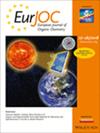Nitrile N‐Oxide‐based Fluorescent Probe to Impart Aggregation‐Induced Emission to Alkenes
IF 2.5
3区 化学
Q2 CHEMISTRY, ORGANIC
引用次数: 0
Abstract
Fluorescent probes have been used extensively in chemical biology, allowing the visual observation of bioactive compounds. While many variations of fluorescent probes that react to polar functional groups have been developed, there are few fluorescent probes that directly modify less polar compounds. In this paper, pyrene‐containing nitrile N‐oxide (Pyrene‐NO) has been designed and synthesized as a fluorescent dye clickable to alkenes without a catalyst. Pyrene‐NO shows good reactivity to a terminal alkene, a polymer methacrylate, and a natural unsaturated lipid with internal alkenes to give the corresponding cycloadducts with pyrene as the fluorescent dye. The cycloadducts show aggregation‐induced emission (AIE) behaviors in a poor solvent. While the adducts to 1‐hexene or polymer methacrylate show AIE in water, the adduct to castor oil as a natural glycerolipid shows AIE in MeOH. The AIE behaviors are evidenced by the dependence of fluorescence intensity on the concentration and the enhanced fluorescence at 77 K compared with that at room temperature. It is suggested that aggregation of the cycloadduct in the poor solvent would kinetically suppress the non‐radiative deactivation of the excited state of pyrene based on interactions with oxygen, leading to an increase in fluorescence intensity.腈- N -氧化物基荧光探针对烯烃的聚集诱导发射
荧光探针已广泛应用于化学生物学,使生物活性化合物的视觉观察。虽然已经开发了许多与极性官能团反应的荧光探针,但很少有直接修饰极性较低的化合物的荧光探针。本文设计并合成了含芘腈N -氧化物(pyrene - NO)作为一种无需催化剂即可吸附烯烃的荧光染料。芘- NO对末端烯烃、聚合物甲基丙烯酸酯和具有内烯烃的天然不饱和脂具有良好的反应性,以芘为荧光染料得到相应的环加合物。环加合物在弱溶剂中表现出聚集诱导发射(AIE)行为。1己烯或聚合物甲基丙烯酸酯的加合物在水中显示AIE,蓖麻油作为天然甘油脂的加合物在甲醇中显示AIE。荧光强度随浓度的变化,以及在77 K时荧光较室温时增强,证明了AIE的行为。这表明,环加合物在弱溶剂中的聚集会从动力学上抑制芘激发态的非辐射失活,从而导致荧光强度增加。
本文章由计算机程序翻译,如有差异,请以英文原文为准。
求助全文
约1分钟内获得全文
求助全文
来源期刊
CiteScore
5.40
自引率
3.60%
发文量
752
审稿时长
1 months
期刊介绍:
The European Journal of Organic Chemistry (2019 ISI Impact Factor 2.889) publishes Full Papers, Communications, and Minireviews from the entire spectrum of synthetic organic, bioorganic and physical-organic chemistry. It is published on behalf of Chemistry Europe, an association of 16 European chemical societies.
The following journals have been merged to form two leading journals, the European Journal of Organic Chemistry and the European Journal of Inorganic Chemistry:
Liebigs Annalen
Bulletin des Sociétés Chimiques Belges
Bulletin de la Société Chimique de France
Gazzetta Chimica Italiana
Recueil des Travaux Chimiques des Pays-Bas
Anales de Química
Chimika Chronika
Revista Portuguesa de Química
ACH—Models in Chemistry
Polish Journal of Chemistry.

 求助内容:
求助内容: 应助结果提醒方式:
应助结果提醒方式:


